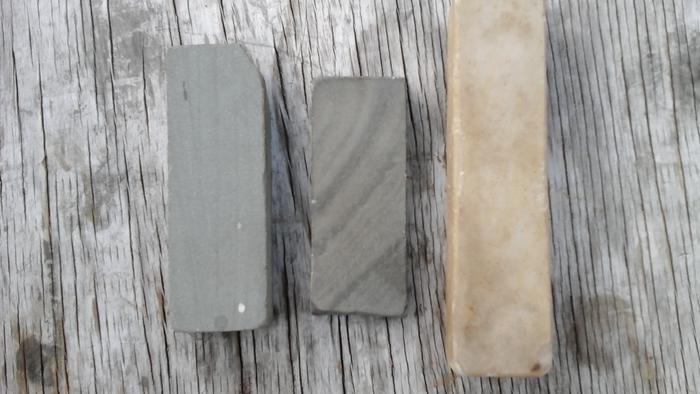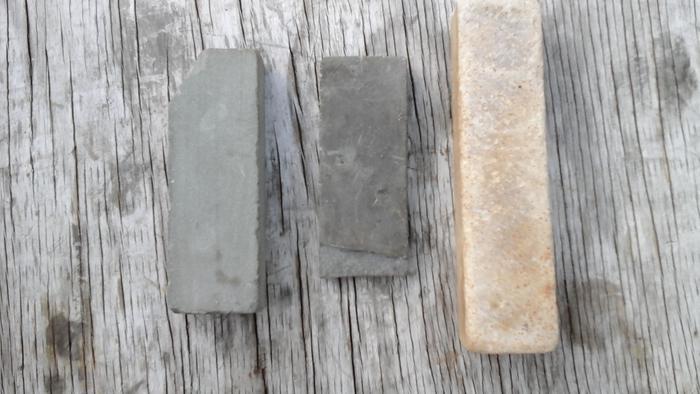Results 11 to 19 of 19
Thread: Hindostan hone.
-
10-11-2016, 04:46 AM #11Member

- Join Date
- Oct 2016
- Location
- Australia
- Posts
- 59
Thanked: 20
The chisel shown was worked with a medium grit Norton Crystolon stone prior to the Hindustan stone. The Hindustan was 1st trialled using Honing Oil, but was rejected soon after due to the dulling effect it had on the cut of the stone. Using water as a stone lubricant was much more successful. Taking into account the rate of cut, and the size of the wire edge formed, my personal opinion is that this stones characteristics was comparable to a Mst Muller 8000 grit.

Testing the sharpness of cutting edge (straight from the stone). The cutting edge was good enough to cleanly slice through the end grain fibres, but slightly more effort was required, compared to that of another chisel, by the same maker, to the same bevel angle specs, but taken to a higher grit of 12000+ on my Welsh Llyn Idwall Grecian Hone.

StewieS.Last edited by StewieS; 10-11-2016 at 05:28 AM.
-
10-11-2016, 02:10 PM #12

Hindostan Stones were sold from nearly all the bigger Stone Quarrying Companies, Tool Makers and Trading Companies. The offered mostly two different qualities. To name some of the companies:
- Pike Mfg. & Co. (US)
- William F. Osborn
...have the list somewhere, need to seach for it....
As far as i remember all the historical sources named that the variances are quite big,
the stones show tidal layers which were also used to research historical tidal movements. Those layers do appear in different amounts (they can reach from 9 to 32 layers). The space between those layers can reach from a few mm to some inches or less then 3inches.
Also the coloration seems not be constant and ranges from a yellow, brown towards a reddish or even white coloration.
The stones were also used as a Tombstone on the graveyards. see that reference here:
Whetstone Gravestones » American Scientist
More about the research on tides can be found here, i posted this earlier:
https://igs.indiana.edu/FossilsAndTime/Tidal.cfm
A short quote from that source:
"If you understand the semi daily tidal cycles and the tidal cycles related to the phase of the moon, you can see how tides have affected the thicknesses of the layers in the delicately layered Hindostan whetstone beds. At this point, you are beginning to understand how rocks can record time. You may also be beginning to understand how geologists are able to determine how rocks were originally deposited. We know the whetstone beds were deposited by tides because we know of no other process that would produce such regular thickness changes in the layers of the rock."
Special selected stones and trademarks:
Those stones also appeared in special cut sizes called "Glassmaker Stones", Pike Mfg. also offered different qualities of the Hindostan stones sold as "Hindostan Hackers" or "Hacker Stone".
"The extra Hindostan Hackers are choice, selected white stones, all full size, polished, each stone wrapped in tissue paper and packed in 2 or 3 dozen boxes, and 6 or 4 of these boxes in a case. No. 1 are all good, full sized stones, packed 1 gross in a case.
No. 2 are taken out of the extra and and No. 1 as not good enough for those grades."
Taken from - Pike Mfg. Catalog (1889)
"Hindostan stones are soft and fine gritted and are extremely useful for general sharpening purposes. Best results are obtained by using water. They are supplied in three grades: hard, medium and soft, respectively."
Taken from - Pike Mfg. Catalog 14 (1926)
"Fastcut - These Stones are made from selected Hindostan stock, neatly finished and packed in attractive individual pasteboard boxes. They cut rapidly and impart a medium coarse edge."
Taken from - Pike Mfg. Catalog 14 (1926)Last edited by doorsch; 10-11-2016 at 02:33 PM.
███▓▒░░.RAZORLOVESTONES.░░▒▓███
-
-
10-11-2016, 04:22 PM #13Member

- Join Date
- Oct 2016
- Location
- Australia
- Posts
- 59
Thanked: 20
Thankyou doorsch; some excellent historic data within your post.
regards StewieS.
-
10-11-2016, 04:32 PM #14Senior Member


- Join Date
- Aug 2014
- Location
- East Central Illinois
- Posts
- 782
Thanked: 101
I won't be able to get down in that area till next summer but really the best time to look for the quarries is in the dead of winter when the trees & bushes are bare.
Total knee replacement on the 18th. will keep me off my feet for a while.
Slawman
-
05-27-2017, 09:15 AM #15

When I got mine it was black as night. Then dark brown to brown to light brown. Then tan and now whitish tan. Wow it is solidly in 8k range a lot smothef than I thought and is
8x2x1 3/8 in thick, needless to say i'm keeping it.
-
05-28-2017, 03:20 AM #16Member

- Join Date
- Mar 2016
- Location
- indiana
- Posts
- 54
Thanked: 9
I scored a couple Hindos off the bay.The first one looked like a bar of tar but after a simple green soak turned in to a very finely layered tan and red beauty. I have 2 approx the size of yours. One was used with diesel fuel and despite months of simple green soaks and boiling 3 times in more aggressive degreasers, it still weeps stinky fuel oil. This stinky one is the only one I've tested so far. Reminded me of a Ohio Blue stone (Queer Creek). I'm from Indiana and never new these existed until I found this forum! I'm not skilled enough to estimate a grit.
Since the red is from iron leaching, I suppose it's permanent. If there is a way to attack it, I'm real interested. It laughed at CLR.
-
05-28-2017, 03:52 AM #17



I use easy-off it works very good. Please be carefull and wear gloves(use outside if you can) and wash with simple green after, it is strong. I did four coats and washed in between with simple green. Good luck with youre stones!
-
05-28-2017, 10:16 PM #18Senior Member



- Join Date
- Apr 2012
- Location
- Diamond Bar, CA
- Posts
- 6,553
Thanked: 3215
You cannot grit rate a stone, comparing one natural stone to another, because natural stones have no grit rating.
You can compare, the stria pattern of a known grit, synthetic stone, to the stria pattern of a natural stone on the same steel.
Hone the razor or steel on the known grit synthetic, hone half the steel on the natural and compare stria microscopically.
Once you grit match, the stone, you know approximately the grit potential of that stone, at that time.
There is no guarantee, that the grit will not change from one side to the other, or as it wears a 32nd of an inch. There was not quality control, when the Natural stone was made, it is… natural.
You can clean the stones, by soaking in Simple Green, Awsome, or other degreaser and water (50 percent). A Hindostane can take months, changing the solution every week or two.
Keep changing the solution until oil is no longer released, one took over a year.Last edited by Euclid440; 05-28-2017 at 10:50 PM.
-
The Following 2 Users Say Thank You to Euclid440 For This Useful Post:
Srdjan (05-29-2017), Toroblanco (05-29-2017)
-
05-29-2017, 07:38 AM #19

Hello Euclid440, that is what I do exacly. I have a laica microscope(studied microbology under Elain R. Ingham University of oregon in Corvalis in 2004)very high quality to see those little buggers. I finaly found another use(looking at the bevels) and it has been invaluable to my learning process.I started with a set of naniwas, so that is what I compare my naturals to. You are very right when you say things could change very quickly, my frst Jnat taught me this(no longer have that one) when I said 8k I was thinking for me, I should have said 7-9k.


 19Likes
19Likes LinkBack URL
LinkBack URL About LinkBacks
About LinkBacks






 Reply With Quote
Reply With Quote
